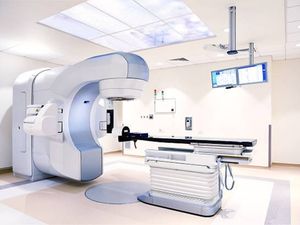A recently approved and widely adopted imaging study that improves detection of prostate cancer recurrence in patients who have undergone radical prostatectomy is having an unintended effect of delaying potentially life-saving salvage treatment with radiation and androgen deprivation therapy, according to a study led by Anthony Victor D’Amico, MD, PhD, chief of Genitourinary Radiation Oncology, Dana-Farber Brigham Cancer Center.
Published in the Journal of Clinical Oncology, the study of 25,551 men found that delaying post-radical prostatectomy salvage radiation therapy (sRT) for patients with one high-risk factor (a prostatectomy Gleason score of 8–10 or evidence of extension of the cancer beyond the prostate at the time of prostatectomy based on evaluation of the prostatectomy specimen) appears to raise the risk of death by approximately 50%.
“Our previous research showed that patients with two or more of these risk factors should have sRT immediately after surgery, when PSA levels are undetectable [i.e., < 0.02 ng/ml], as they are at highest risk of dying from the disease,” Dr. D’Amico says. “This new study sought to address the risk of mortality among patients with only one risk factor. Is it still safe to wait for the PSA to rise?”
New Imaging Technology More Sensitive, but Comes with Caveats
Prostate-specific membrane antigen positron emission tomography (PSMA-PET) compared with conventional imaging (bone scan, computed tomography, or magnetic resonance imaging of the abdomen and pelvis) seems to improve the detection of clinical recurrence in men with PSA failure and a PSA level of at least 0.20 ng/mL after radical prostatectomy.
However, the imaging study accuracy improves with increasing PSA levels and isn’t reimbursable until PSA levels are at an insurance-specific threshold typically above 0.3 ng/ml—at which point, salvage treatment with radiation and androgen deprivation therapy is less likely to be effective.
“At Dana-Farber Brigham, we tend to be more medically conservative and not allow these restraints to drive patients to a potentially lower cure rate,” Dr. D’Amico says. “In order to improve curability, in most cases, we would want to start sRT at a PSA level of 0.1 ng/ml to decrease the risk of the cancer metastasizing and becoming resistant to salvage treatment with radiation and androgen deprivation therapy.”
Dr. D’Amico expresses hope that the result of the study will be inculcated among payers and that they will change their policies to allow PSMA-PET to be reimbursed at lower PSA levels.
Sophisticated Statistical Methodologies a Hallmark of Dana-Farber Brigham Research
Dr. D’Amico conducted the study with a multinational group of colleagues, using advanced concepts in statistical methodology that he says are a hallmark of Dana-Farber Brigham’s research competency and not consistently seen in the medical literature.
The team used multivariable Cox regression analysis beginning at a PSA level of 0.10 ng/mL and in 0.05 increments up to 0.50 ng/mL versus at or below that level. The model was adjusted for age at and year of surgery, established prostate cancer prognostic factors, institution, and time-dependent use of androgen deprivation therapy.
“These multimodal adjustments allowed us to see if there was a threshold effect in PSA level or if the impact of the delay in salvage therapy led to an increased risk of death with increasing PSA level,” Dr. D’Amico says.
The study did indeed find a threshold effect. Once patients had a PSA level of 0.25 or beyond, the risk of mortality increased by approximately 50% without sRT. At that point, Dr. D’Amico says, some patients lose the chance for cure.
In commenting on the study’s clinical relevance, Journal of Clinical Oncology associate editor Michael Carducci, MD, states: “Initiating salvage radiotherapy postprostatectomy before PSA exceeds 0.25 ng/mL is made clearer in this report. With wider use of ultrasensitive PSA in high-risk individuals, individuals can move to salvage therapies before novel imaging can identify sites of persistent disease.”
Dr. D’Amico plans to build on this research by studying patients who don’t have any risk factors or are at low risk of recurrence or mortality by investigating whether there is a PSA threshold at which every patient is a candidate for salvage therapy.
